AMD Radeon HD 7770 - Seizing the Day with Cape Verde, the ASUS Way
Cape Verde is the codename for the GPU that will populate the Radeon HD 7700 series. ASUS was the first to send us their iteration with the Radeon HD 7770 DirectCU TOP 1GB GDDR5 graphics card. Join us in this quick review and find out how this new mainstream card fares.
By Wong Chung Wee -
Introducing Cape Verde - The 7700 Series Family
It has been just over a month since AMD launched their high performance Radeon HD 7900 series with the Tahiti GPUs taking the first salvo of the Southern Islands family. Already grabbing the most powerful single GPU graphics card title, it's probably certain that the yet-to-be launched dual-GPU based Radeon HD 7990 would snag the crown of the most powerful consumer graphics card on the planet - that is if it can see the day of light before NVIDIA makes their move first.
While the high-end battleground seems secured, AMD wastes no time to launch yet another GPU of the Southern Islands family codename Cape Verde. This new offering from AMD is targeted at the mainstream performance segment of less than US$200 and boasts the same new GCN architecture as well as their 28nm fabrication process of the high-end Tahiti-class GPU. The main difference of course is the number of GCN modules making up the graphics core, memory bandwidth being cut down and the other usual trappings of a mainstream GPU.

After Tahiti's launch, we were expecting to see the clan of Pitcairn but instead, we were greeted with Cape Verde. Nevertheless, we'll check out what it means for the mainstream audience.
The AMD Radeon HD 7700 Family
In keeping with tradition, AMD has offered two SKUs from the Cape Verde clan and they are AMD Radeon HD 7770 and AMD Radeon HD 7750. One of the key points AMD touted of this series is of the Radeon HD 7770 as the first GPU with a rated clock speed of 1000MHz and is a successor to the previously popular ATI Radeon HD 5770. As tabulated in the table below, the US$159 suggested retail price of the Radeon HD 7770 would go up against graphics cards from NVIDIA's GeForce GTX 550 Ti and the Radeon HD 6790 - both of which currently retail around US$130 to US$150. For this article, we'll be focusing on the Radeon HD 7770 as we'll be reviewing an ASUS card based on this GPU.
Just to get an idea of how the Radeon HD 7000 series family stack up currently, we've got the 7900 and 7700 series compared in brief:-
Model | AMDRadeon HD 7970 | AMDRadeon HD 7950 | AMDRadeon HD 7770 | AMDRadeon HD7750 |
Core Code | Tahiti | Tahiti | Cape Verde | Cape Verde |
Transistor Count | 4300 million | 4300 million | 1500 million | 1500 million |
Manufacturing Process | 28nm | 28nm | 28nm | 28nm |
Core Clock | 925MHz | 800MHz | 1000MHz | 800MHz |
Stream Processors | 2048 Stream processing units | 1792 Stream processing units | 640 Stream processing units | 512 Stream processing units |
Stream Processor Clock | 925MHz | 880MHz | 1125MHz | 1125MHz |
Texture Mapping Units (TMU) or Texture Filtering (TF) units | 128 | 112 | 40 | 32 |
Raster Operator units (ROP) | 32 | 32 | 16 | 16 |
Memory Clock | 5500MHz GDDR5 | 5000MHz GDDR5 | 4500MHz GDDR5 | 4500MHz GDDR5 |
DDR Memory Bus | 384-bit | 384-bit | 128-bit | 128-bit |
Memory Bandwidth | 264GB/s | 240GB/s | 72GB/s | 72GB/s |
Street Price | Launch Price:US$549 | ~US$449 | ~US$159 | ~US$109 |
Breaking the 1000MHz Barrier
We have on our hands the ASUS Radeon HD 7770 DirectCU TOP 1GB GDDR5 (HD7770-DCT-1GD5) that features an overclocked Cape Verde GPU. Its rated clock speed is 1120MHz which is 12% higher than the default suggested clock speed of 1000MHz. As such for this article, we'll be focusing only on the Radeon HD 7770 and its performance aspects as displayed by this ASUS graphics card.

With its DirectCU cooling technology, ASUS has clearly stated that its cooling technology is supposedly able to make the card 20% cooler against stock coolers. We'll have to verify that another day when we do get a reference card for comparison.
Keeping Things Cool
With its customized DirectCU cooling solution, it adds a touch of premium quality to the build of ASUS Radeon HD 7770. During our test of the card, its 40mm fan was noticeably quiet as it went about its business of keeping the GPU cool.

We have a top view of the card and we can see the twin 8mm DirectCU heatpipes that draw heat away from the overclocked Cape Verde GPU.

The heatpipes draw heat away from the DirectCU heatsink that sits directly on the Cape Verde GPU.
Up Close and Personal
On a cursory glance, the card bears a slight resemblance to ASUS EAH6850 DirectCU.The card measures 22.5cm in length when measured from the edge of its metal backplate to the rightmost edge of the plastic shielding of its heatsink.

Notice how the plastic shielding of its DirectCU heatsink extends slightly beyond the PCB of the graphics card.

For video output connectivity, the ASUS card has one DVI connector, a single HDMI port and two mini DisplayPorts.
Skin Deep Tweaks
Bundled with the card is the latest tweaking software is the ASUS GPU Tweak. With this nifty utility, you can tweak your card as well as update its drivers and BIOS for optimal performance.

The ASUS GPUTweak is a useful utility for tweaking and managing your AMD Radeon 7000 series of cards. We have also used earlier versions of this software for other cards based on different GPUs.
Test Setup
As usual, the following are the specs of our trusty graphics card test bed system:-
- Intel Core i7-975 (3.33GHz)
- Gigabyte GA-EX58-UD4P motherboard
- 3 x 1GB DDR3-1333 G.Skill memory in triple channel mode
- Seagate 7200.10 200GB SATA hard drive
- Windows 7 Ultimate 64-bit
Due to time constraints, we weren't able to compare an exhaustive list of graphics cards, nor update our previous comparison results to the latest drivers. Still, we believe that the shared data would be reasonable for an understanding of how the Radeon HD 7770 fares in the big picture. As pointed out on the first page, the Radeon HD 7770 is priced to compete against the NVIDIA GeForce GTX 550Ti and hopefully even against the older AMD Radeon HD 6790.
The version of the AMD Catalyst drivers used for the Radeon HD 7770 is version 12.1, even newer than those used for our Radeon HD 7900 series article.
The list of cards tested and driver versions used:
- ASUS Radeon HD 7770 DirectCU 1GB GDDR5 (AMD Catalyst 12.1)
- AMD Radeon HD 6790 1GB GDDR5 (AMD Catalyst 11.4)
- NVIDIA GeForce GTX 550 Ti 1GB GDDR5 (ForceWare 266.71)
The list of extra cards that were used power and temperature comparison:
- MSI N550GTX-Ti Cyclone II 1GB GDDR5 (ForceWare 266.71)
- Palit GeForce GTX 550 Ti Sonic 1GB GDDR5 (ForceWare 266.71)
- HIS 6790 IceQ X Turbo 1GB GDDR5 (AMD Catalyst 11.4)
In moving with the times, we have updated our benchmarking software to include three other gaming titles to the mix - Crysis 2, Batman: Arkam City and Dirt 3. For these 3 games, we're using the newest drivers for all the comparison cards at the time of writing. Note that we've excluded Unigine v2.1 and S.T.A.L.K.E.R. for the time being as we're reserving them for the full Radeon HD 7700 series comparison where more emphasis will be placed on their DX11 capabilities.
The list of benchmarks used:
- Futuremark 3DMark 11
- Futuremark 3DMark Vantage
- Crysis Warhead
- Far Cry 2
- Crysis 2
- Batman: Arkam City
- Dirt 3
3DMark 11 and 3DMark Vantage Results
The ASUS HD 7770 outclassed the competition and its performance was almost 20% higher than AMD Radeon HD 6790 at Extreme setting. It managed to widen this margin to a whopping 40% against NIVIDA GeForce GTX 550 Ti. Of course the numerical differences might seem small, but bear in mind we're comparing mainstream class graphics cards.

The card also came out tops for its 3DMark Vantage scores at all settings though its winning margins were thinned, it still managed to outperform GeForce GTX 550 Ti by about 32% at the Extreme preset.

Crysis Warhead
The scores of ASUS HD 7770 were slightly lower by margins from 3 to 9%, with the latter percentage difference for the benchmark with anti-aliasing at 4x settings. The card maintained its lead over GeForce GTX 550 Ti with respective margins of at least 14%. Bear in mind that we're assessing an overclocked Radeon HD 7770, so the actual stock-clocked card would probably have very little advantage over the NVIDIA counterpart.
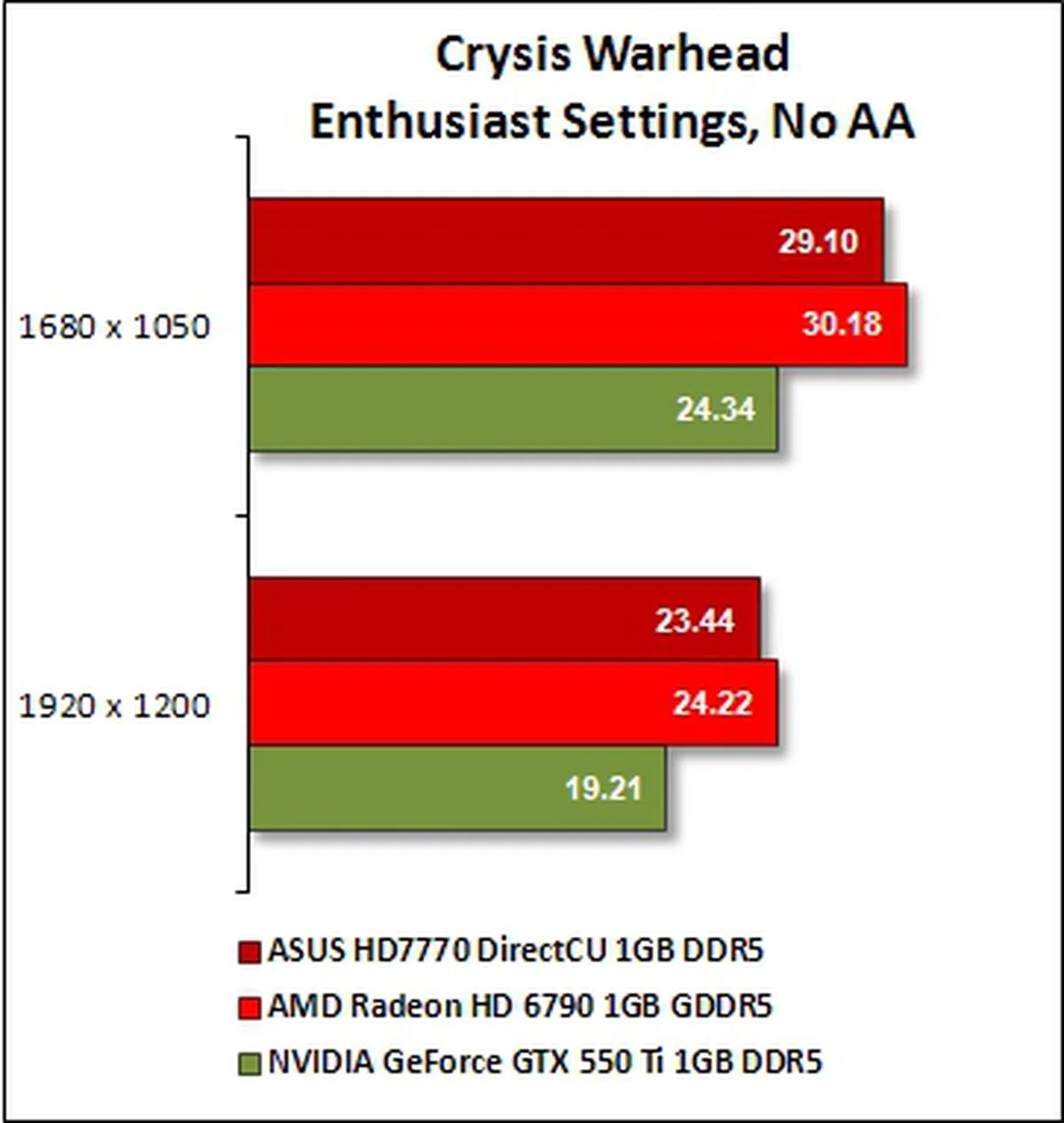 | 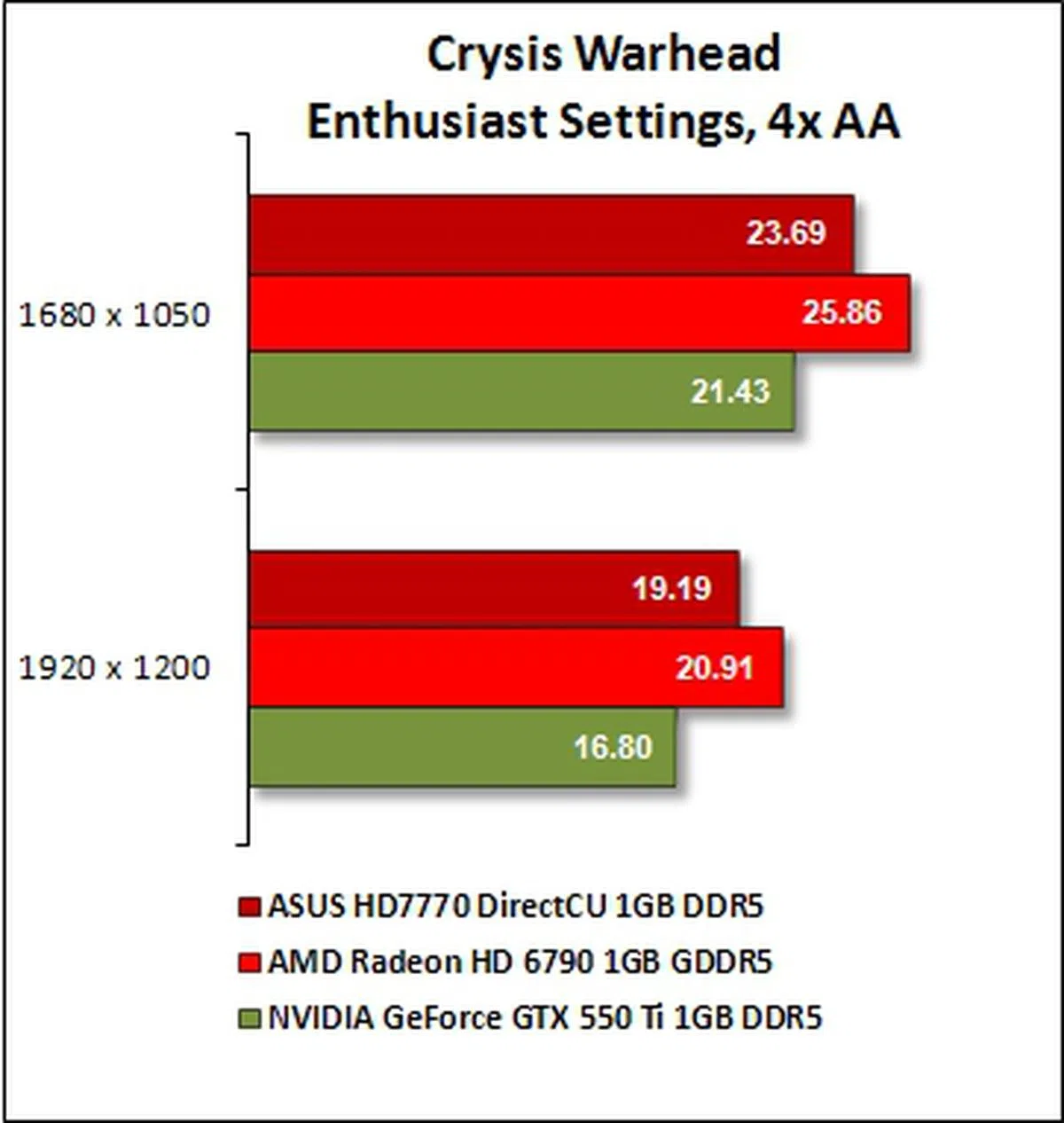 |
Far Cry 2
For Far Cry 2, its main competitor was from the NVIDIA camp and ASUS HD 7770 did not manage to outperform GeForce GTX 550 Ti. From past experience, this benchmark has been a stronghold of performance for NVIDIA graphics cards and it was no surprise in this comparison again. It did however fair about 11% better than the Radeon HD 6790.
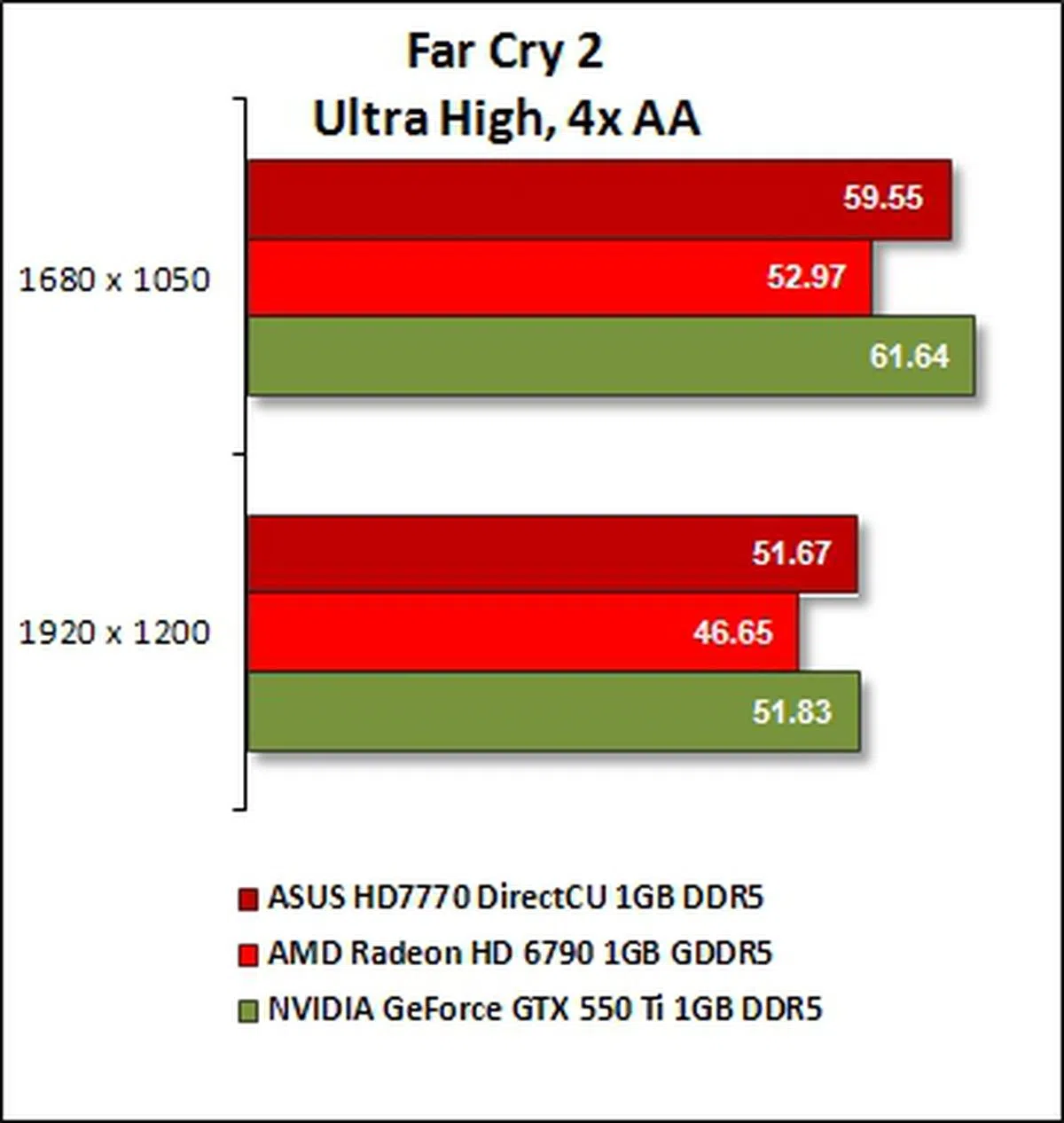 | 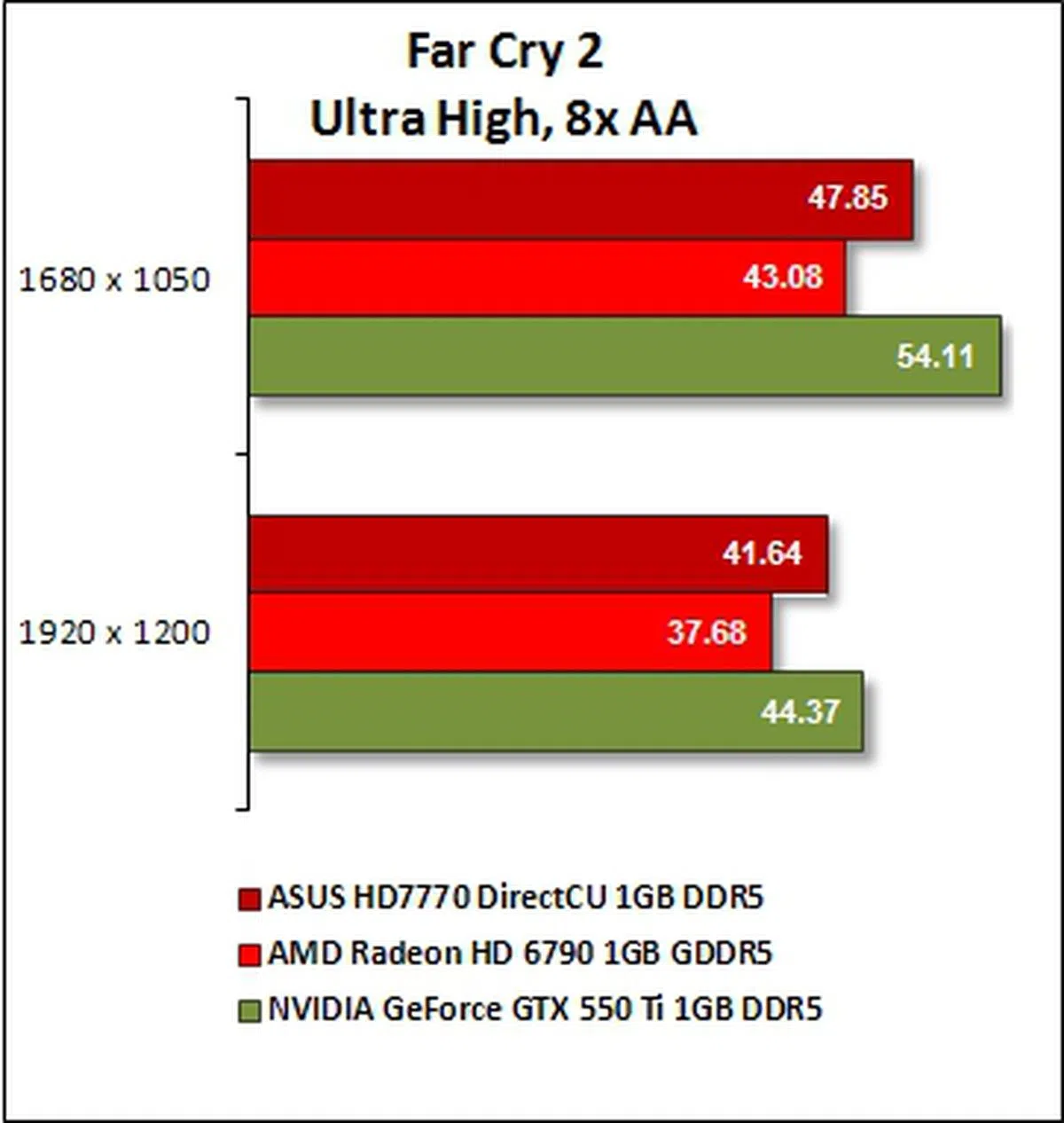 |
Crysis 2 Results
ASUS HD 7770 managed to beat Radeon HD 6790 by a margin of approximately 6% at the resolution of 1680 x 1050; while at the higher resolution, the margin widened to roughly 10%. NVIDIA GeForce GTX 550 Ti was nipping at the heels of the leader at the lower resolution and was beaten by a similar 10% margin at the resolution of 1920 x 1200. Note that we used a lower quality setting (High), as opposed to the high-end graphics cards recently tested.

Batman: Arkham City Results
The cards seems to have flatlined for this test with frame rates hovering between the values of 36 to 38. This is despite the fact that we've already adjusted the game settings to fit these mainstream oriented cards as high quality settings are clearly out of reach for this class of graphics cards. The exception was NVIDIA GTX GeForce 550 Ti that pulled ahead of the AMD pack by approximately 36%!

Dirt3
In our last DX11 oriented game, the ASUS Radeon HD 7770 beat Radeon HD 6790 in this benchmark by a steady margin in the range of 13 to 17%. This is to be expected from an overclocked card like the ASUS, but this would mean that the Radeon HD 7770 on its own won't fare much better than the old 6790 cousin. NVIDIA GeForce GTX 550 Ti failed to repeat its feat in the previous gaming benchmark and was trailing behind the pair of AMD graphics cards. Its frame rate dropped below 30fps to 28.1fps at the resolution of 1920 x 1200 with MSAA set at 8x.
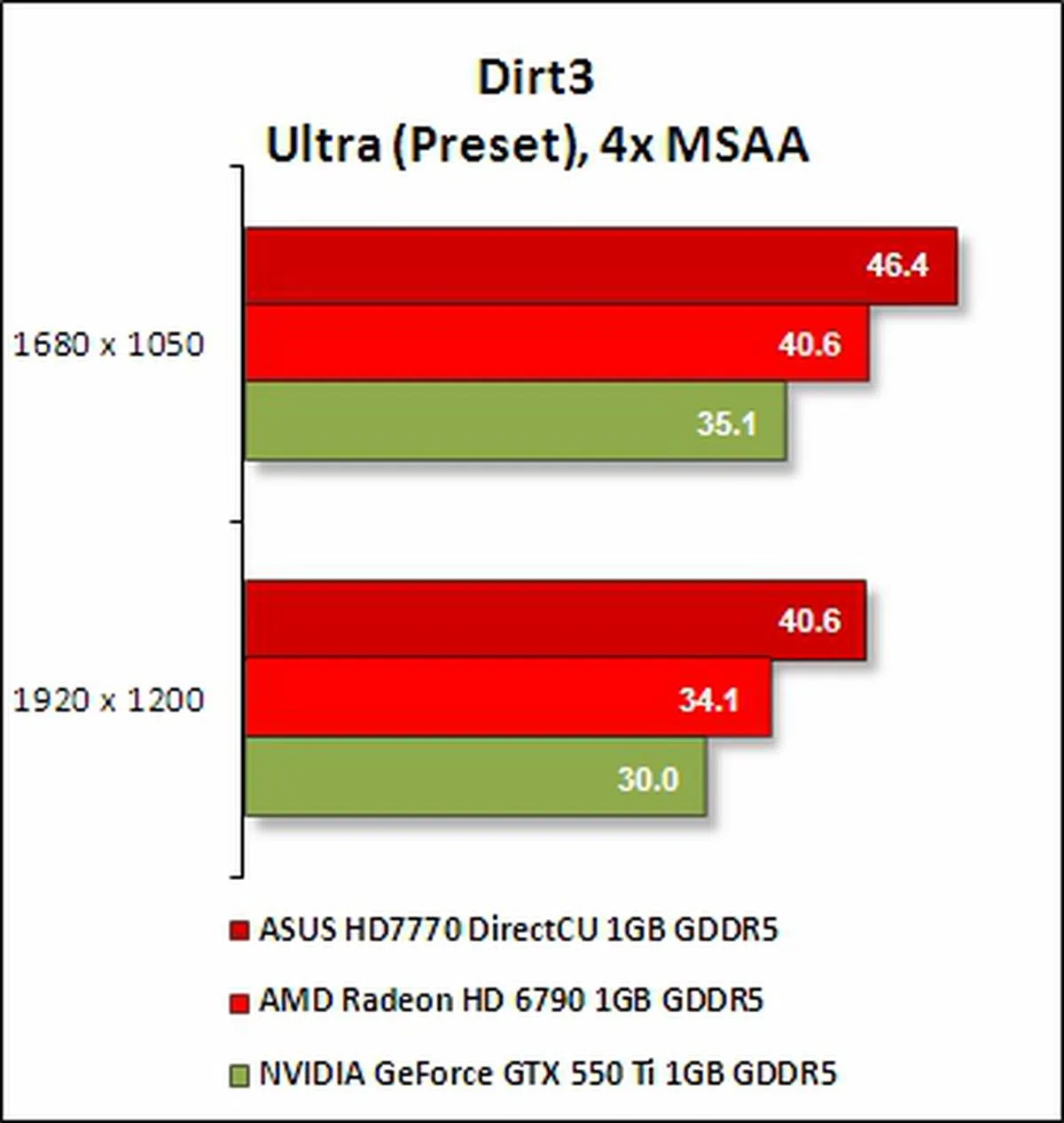 | 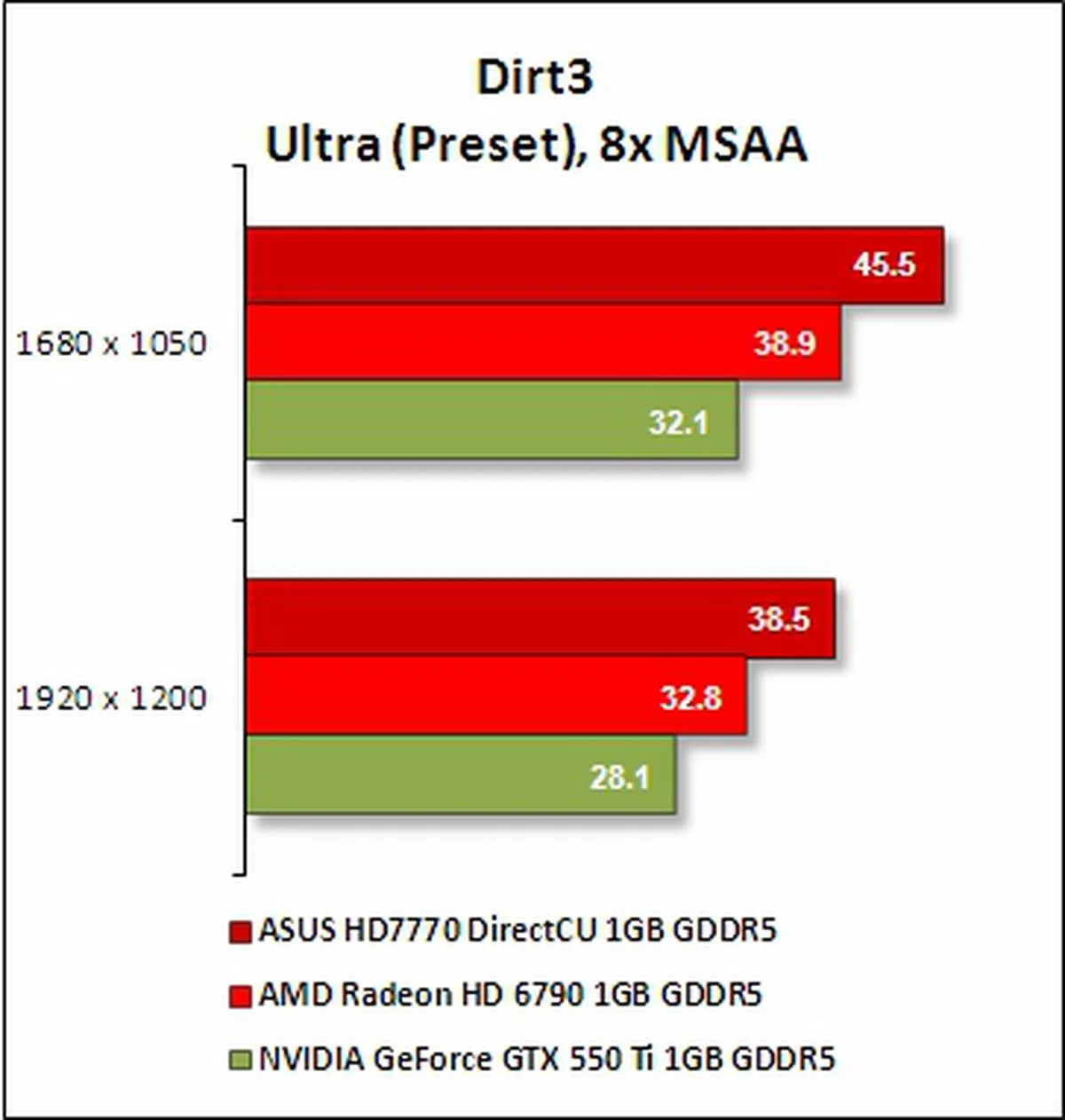 |
Temperature
The ASUS HD 7770 runs at cool 48.0 degrees Celsius in our test run which we found rather reasonable. At the moment, we lack a reference AMD Radeon HD 7770 to check the claims of ASUS and its DirectCU cooler that's touted to run 20% cooler. To that extent, the reference edition of the GeForce GTX 550 Ti and the Radeon HD 6790 never came our way either. As such, we've included comparison graphics cards from the board vendors we've reviewed in the past, such as MSI and Palit from the NVIDIA contingent and HIS from the AMD camp were included for references.

Power Consumption
The power consumption of the ASUS Radeon HD 7770 DirectCU TOP edition appears to be the lowest compared to the rest of the cards, regardless whether they were measured when the cards were idle or on load. Respective cards from the various vendors were included to fill in the lack of reference graphics cards in the mainstream arena. The results also indicate that the standard clocked Radeon HD 7770 would likely consume even lower power than this ASUS card and that's something we'll check out once we obtain the reference cards from AMD in due time.

The Day Was Seized But To No Avail
The ASUS HD 7770 DirectCU TOP 1GB GDDR5 is an overclocked graphics card featuring the Cape Verde GPU running at 1120MHz and we expected it to be pitted against GeForce GTX 560 at the very least. After studying the initial benchmark figures, we had to take our expectations a down a notch and settle for GeForce GTX 550 Ti. While AMD did mention that the Radeon HD 7770 was meant to take on the GeForce GTX 550 Ti, we expected much better from an overclocked card. This means that a reference Radeon HD 7770 would actually fare slightly worse than this well equipped ASUS card we've reviewed and that's nothing to should about for a brand new GPU model.
From the AMD camp, while the company would like to call it the successor to the Radeon HD 5770, we would much rather compare the newcomer against presently available cards from the Radeon HD 6700 series. We took the liberty to pit the Radeon HD 7770 directly against an AMD Radeon HD 6790 by virtue of its current price point. To be honest, we never really quite liked the Radeon HD 6700 series because of their odd positioning and price as we would rather recommend someone on a budget to keep to a Radeon HD 6670 or spend a bit more for a much more powerful Radeon HD 6850 graphics card. As such, once we found out the capabilities of the new 7770 model, we were disappointed.

The estimated retailed price of ASUS HD 7770 is US$160 but the TOP edition we've reviewed will cost even more (pricing was unavailable at the time of review). Given its already modest performance scores, it does not quite stand out from the competition of older graphics cards from AMD and NVIDIA. As such, we weren't impressed by this newcomer.
Its performance can be described as anemic as given the fact that the card features an overclocked GPU with DirectCU cooling solution. The numbers it turned in did not impress us and we expressed earlier that it fared the worst for the Batman: Arkham City gaming benchmark; even with DX11 features turned off, it only managed generate frame rates of 38fps and wasn't any better than the compared predecessor.
With that said, it was not all bad for ASUS HD 7770 DirectCU TOP as it features the Cape Verde GPU which boasts of the same features as the other GPUs from Tahiti albeit they are implemented on a modest scale for Cape Verde. It has less GCN CUs than its Tahiti brethren and its memory bandwidth has been whittled down to 12GB/s due to its 128-bit memory bus channel. Its GPU is made from the same 28nm fabrication process as the Tahiti ones. In addition, ASUS HD 7770 features the same AMD proprietary technologies like AMD PowerTune, ZeroCore as well as Eyefinity; for easily setting up and configuring multiple monitors, and HD3D; for stereoscopic 3D.
This meant that the card ran very cool and consumed very low power as found out on the previous page, while offering features like HDMI 1.4a and DisplayPort 1.2 (in the form of two mini DisplayPorts) to easily setup several displays powered on just one card. This is one area where most of NVIDIA's solutions have faltered for over a year on something as trivial as multi-monitor setup beyond two displays.
We commend ASUS for an excellent Cape Verde GPU implementation with the ASUS HD 7770 DirectCU TOP graphics card, but the GPU's less than ideal performance had dashed most of our hopes of it making a difference in the graphics card market. Further to that, when considering that you'll have to pay even more for the TOP edition than the reference target SRP, we feel that the graphics card doesn't really offer an ideal proposition, not much of an advantage over existing graphics cards.
In the end, it seems like the Radeon HD7770 is unfortunately in same dilemma as its predecessor was without any clear territory to claim. While there's really nothing wrong with this series and this particular graphics card if you really want to go ahead to splurge on it, there are better existing options. And if you are one of the many upgraders looking for a good performance mainstream card, do wait a while until a definitive winner (from either AMD or NVIDIA) is unveiled in the next couple of months as there are many more GPUs SKUs to be launched.
Our articles may contain affiliate links. If you buy through these links, we may earn a small commission.